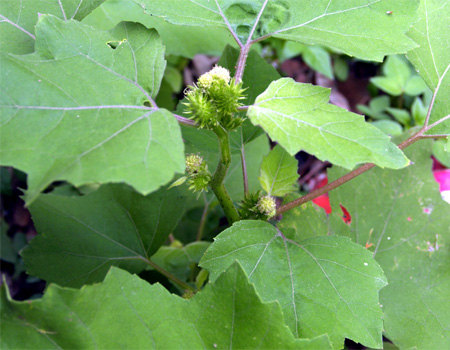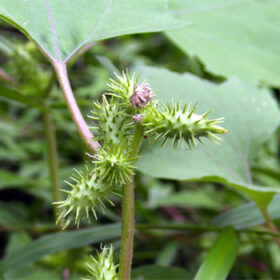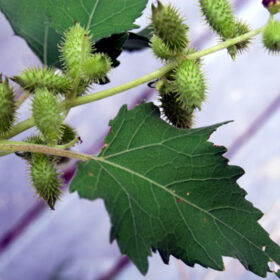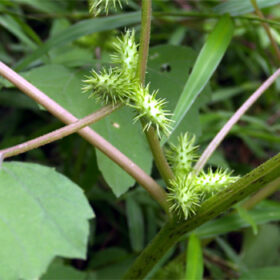Identification:
This is a herbaceous plant, typically upright, with heights ranging from 30 to 60 cm or more, exhibiting extensive branching. The young stem has a near-circular cross-section, sometimes slightly flattened, and is green. The outer surface is covered with numerous rough, white hairs and a few fine hairs, with several prominent longitudinal green veins and brownish-purple spots. Mature stems are round in cross-section and display a greenish-brown color. The leaves are simple, alternate, and lack stipules. The leaf blades can be entire or have 3-(5) distinct or indistinct lobes, with lengths of 8-15 cm and widths of 10-14 cm. The apex is triangular, and the base can be tapering, heart-shaped, or slightly heart-shaped, often extending down the petiole for 0.5-1.5 cm, forming two small wings on either side. The base of the leaf blade can be symmetrical or asymmetrical. The leaf color is green, with the upper surface being darker than the lower surface. Both surfaces are covered with rough, white hairs and a few fine hairs. The leaf margins have irregular, wavy serrations. The venation is palmate, with 3 prominent basal veins visible on the underside, and secondary veins slightly curving towards the leaf tip. The petioles are 7-12 cm long, cylindrical, slightly widened at the base, and reddish-brown and slightly concave on the upper surface, and green on the underside. The petiole has numerous rough, white hairs and a few fine hairs.
The pseudocarp is ovoid or fusiform, 2-2.5 cm long, with a diameter of 1-1.5 cm, and two horns on the top, 5-7 mm long. The horns are often of unequal length, with a swollen base and a tapering tip. The outer shell is yellowish-gray or brownish-gray, hard and tough, with hook-shaped spines on the outer surface, 3-5 mm long, with a swollen base and covered with fine white hairs. Inside, there are two separate compartments divided by a longitudinal septum, each containing a true fruit. The two true fruits are unequal in size. The true fruit is a straight achene, oblong-elliptical with pointed ends, 12-20 mm long, and 6 mm in diameter, flattened on one side and convex on the other, with a dark purplish-black color. The fruit wall is very thin and easily detached. The seeds are fusiform and pointed at both ends, and the seed coat has many longitudinal wrinkles. The cotyledons are thick and enclose the embryo, with the radicle and plumule located at the narrow end of the seed.
Biology and Ecology:
The plant grows wild in various locations, including roadsides, open fields, abandoned farmlands, and secondary forests. It is found in almost all provinces from Central Vietnam to the South, up to an altitude of 600m. This is a light-loving species that regenerates well from seeds and is also cultivated in many gardens for medicinal purposes. The flowering and fruiting season is from May to August.
Distribution:
The species occurs in India, Vietnam, Thailand, and Indonesia. In Vietnam, the plant grows wild from Thừa Thiên Huế, Khánh Hòa to Tây Ninh, Long An, Đồng Tháp, and An Giang, in hills, roadsides, grasslands, and open areas with abundant sunlight.
Uses:
Fruits are harvested before they turn yellow. They are then dried by sun or by heat. The fruits contain alkaloids, sesquiterpene lactones (xanthinin, xanthumin, xanthatin), and fatty oil. The leaves contain iodine: 200 micrograms per 1g of leaf; the fruits contain 220-230 micrograms/lg of fruit.
It has anti-allergenic and anti-inflammatory properties. It is used to treat boils, ulcers, urticaria, scrofula, goiter, joint pain, rheumatism, painful contractions of the hands and feet, headaches, rhinitis with foul discharge, sore throat, and dysentery. 6-12 g of the decoction, extract, or pills are used daily. A decoction of the fruit is used as a mouthwash for toothache, and it can be applied topically for tinea capitis and ringworm.




